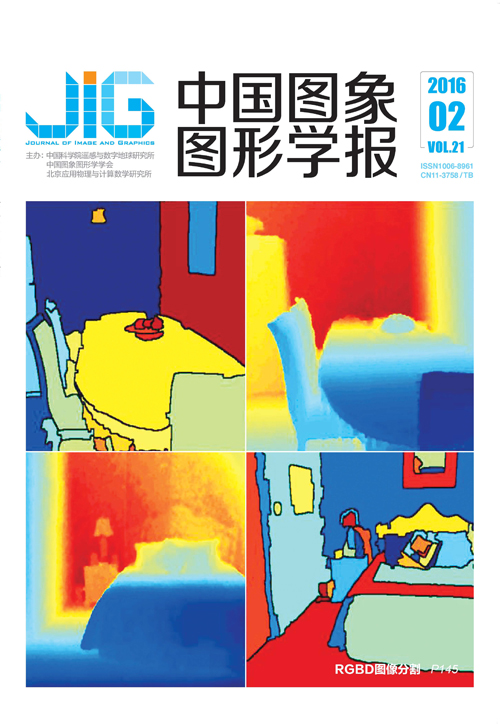
面向RGBD图像的标记分水岭分割
摘 要
目的 针对分水岭分割算法中存在的过分割现象及现有基于RGB图像分割方法的局限,提出了一种基于RGB图像和深度图像(RGBD)的标记分水岭分割算法。方法 本文使用物体表面几何信息来辅助进行图像分割,定义了一种深度梯度算子和一种法向量梯度算子来衡量物体表面几何信息的变化。通过生成深度梯度图像和法向量梯度图像,与彩色梯度图像进行融合,实现标记图像的提取。在此基础上,使用极小值标定技术对彩色梯度图像进行修正,然后使用分水岭算法进行图像分割。结果 在纽约大学提供的NYU2数据集上进行实验,本文算法有效抑制了过分割现象,将分割区域从上千个降至数十个,且获得了与人工标定的分割结果更接近的分割效果,分割的准确率也比只使用彩色图像进行分割提高了10%以上。结论 本文算法普遍适用于RGBD图像的分割问题,该算法加入了物体表面几何信息的使用,提高了分割的准确率,且对颜色纹理相似的区域获得了较好的分割结果。
关键词
Marked watershed segmentation algorithm for RGBD images
Yu Ye, Li Bingfei, Zhang Xiaowei, Liu Yiping, Li Haiqin(VCC Division, School of Computer and Information, Hefei University of Technology, Hefei 230009, China) Abstract
Objective Image segmentation is an important basic operation of image processing. It has a direct effect on subsequent operations such as image analysis and scene understanding. The watershed algorithm is widely used to segment images because of its ability to obtain accurate boundaries. However, this algorithm tends to cause over-segmentation phenomena. Alternatively, segmentation algorithms specific to RGB images cannot radically solve the case wherein regions have similar colors and textures. To solve the over-segmentation problem in the watershed segmentation algorithm and overcome the limitation caused by using only RGB images, a marked watershed segmentation algorithm based on RGBD images is proposed. Method An RGBD image is composed of an RGB image and a depth image. By using depth information, we extract the geometry information of the object to assist the image segmentation process. For RGB images, the probability map of boundary is computed by the PB algorithm and used as the color gradient image in our algorithm. For depth images, a depth gradient operator and a normal gradient operator are defined to measure the differences in geometry information. We use the circular gradient operator with eight orientations. For each orientation, we divide the disk into two half disks along the diameter of the orientation and compute the gradient by using information from the two half disks. For the depth gradient, we obtain the weighted depths of Gaussian weight from the two half disks and consider the depth difference between the two weighted depths as the gradient. For normal gradient, we fit this normals to the points set in the two half disks and compute the angle between the two normal as its gradient. We select the maximum gradient among the different orientations as the final gradient. By fusing the depth gradient image, normal gradient image, and color gradient image, the marker image is extracted. Thereafter, the color gradient image is modified by the marker image using the minimum calibration technique, and the segmentation process is conducted by using the watershed algorithm. Result Our experiments are based on the NYU2 dataset provided by New York University. This dataset includes different indoor scenes and provides the labels of real segmentations. Results show that by extracting the markers and modifying the color gradient image, our algorithm can reduce the number of regions and solve the over-segmentation problem effectively. Furthermore, by using the geometry information of the object, our algorithm can obtain closer results to real labels. The accuracy of the segmentation is improved, particularly for regions with similar colors and textures. Conclusion Specific to RGBD images, we propose a new watershed segmentation algorithm. Except the color gradient image obtained from the general RGB image, we also extract the depth gradient and normal gradient to assist in the image segmentation process. Furthermore, a marked watershed algorithm is used to obtain the final segmentation results. Results show that our algorithm reduces the number of regions and obtains improved segmentation accuracy, particularly in regions with similar colors and textures.
Keywords
|



 中国图象图形学报 │ 京ICP备05080539号-4 │ 本系统由
中国图象图形学报 │ 京ICP备05080539号-4 │ 本系统由